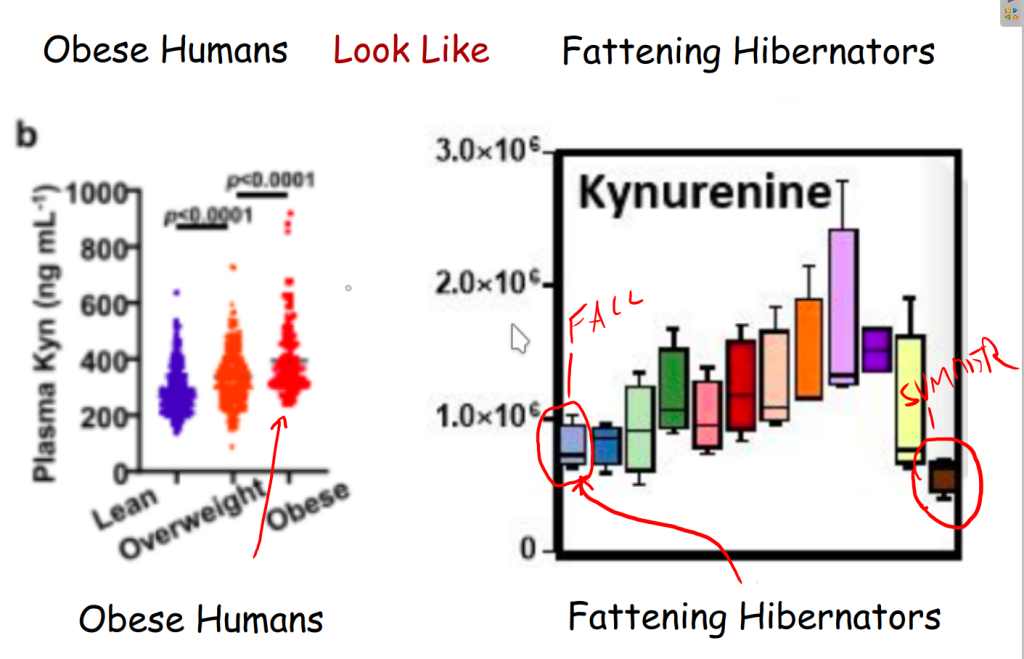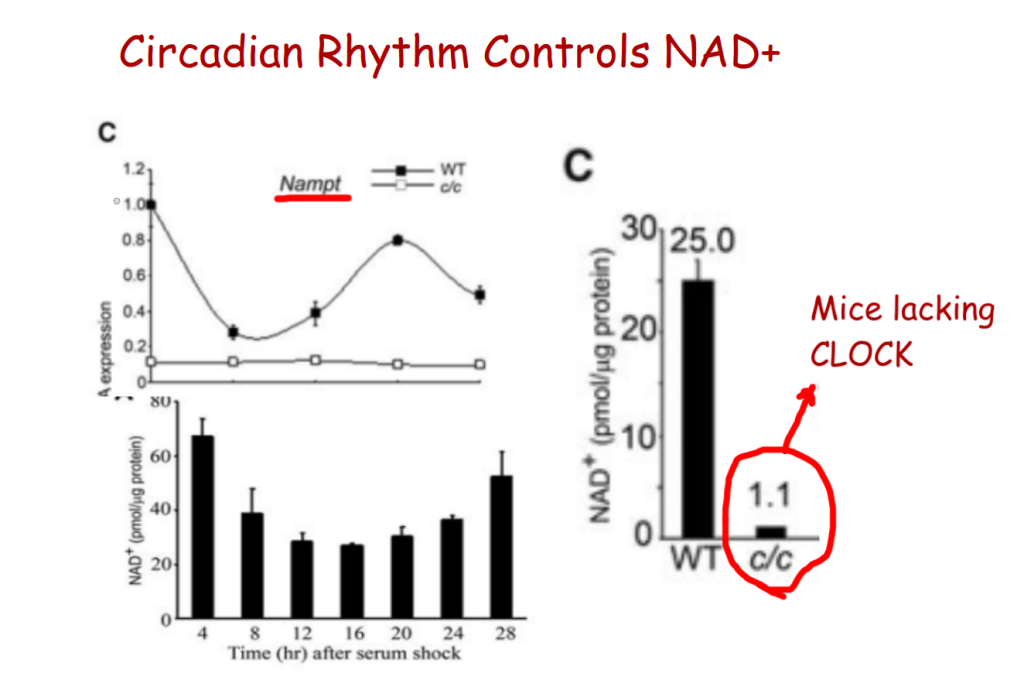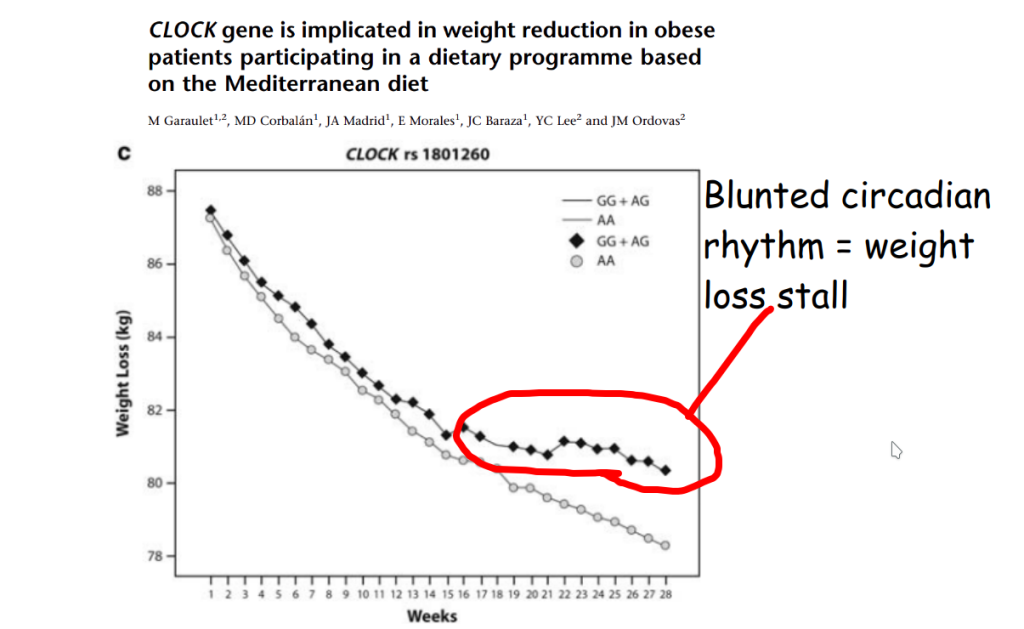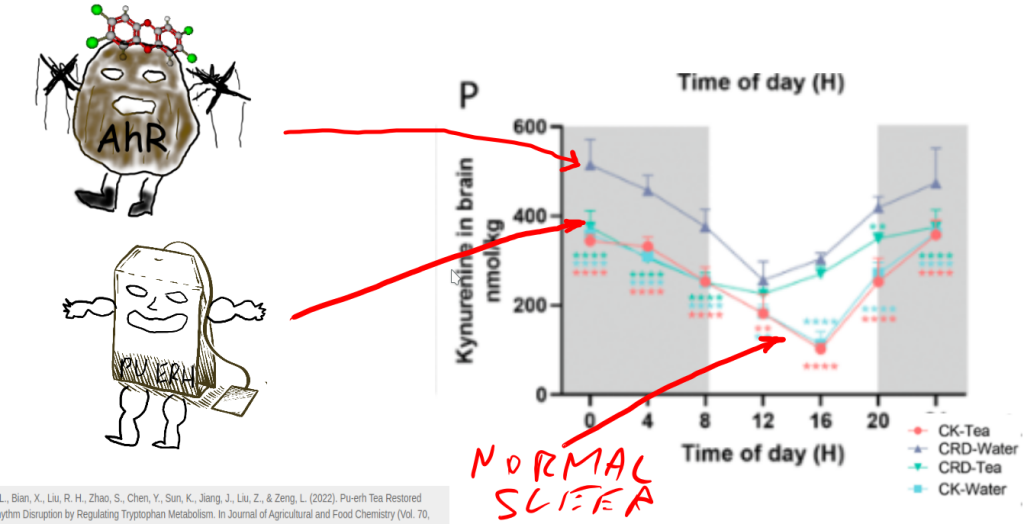Episode 4 of Obesity Explained is out!
Watch The Video!
Video Summary
It’s January. Days are short, the light is dim. This one is about circadian rhythms, daylength, body weight and torpor.
My working hypothesis is that the Aryl Hydrocarbon Receptor is A, if not THE, master regulator of torpor. Kynurenine is a tryptophan metabolite that is elevated in hibernating mammals during the fattening stage of their yearly cycle. Kynuernine is elevated to a similar extent in obese humans.

An elevated AhR shifts your metabolism into a torpor-like state that favors fat storage. One of the ways it does this is by shutting down circadian rhythms. The AhR is closely related to the CLOCK gene – the transcription factor that controls circadian rhythms. Transcription factors are genes that control the expression of other genes. When activated, the AhR displaces the CLOCK gene at the site of the DNA where clock would normally attach and turn on genes that have a circadian rhythm. The AhR blocks transcription of these genes.

NAD+ levels are controlled in a Circadian fashion. The enzyme NAMPT recycles NAD+ after it is converted to nicotinamide by NADase enzymes like the sirtuins, PARPs and CD38. Mice lacking the CLOCK gene – the very gene displaced by an activated AhR – have very low levels of NAD+ and become very fat.

Humans with a less active version of the clock gene experience weight loss stall on a low calorie diet.

Theabrownin and Pu Erh Tea
Pu Erh tea is a fermented tea that has a high quantity of dark brown pigments called theabrownin (brown pigment from tea). The tea and theabrownin reverse the effects of a dysregulated circadian rhythm, probably by inhibiting the AhR and thus lowering kynurenine levels. Kynurenine and the AhR are regulated in a positive feedback loop. The AhR upregulates an enzyme called IDO1 which creates kynuerenine which activates the AhR. Pu Erh tea breaks this loop.

I present evidence in the video that the mechanism of action of Pu Erh tea is likely that theabrownin is a direct inhibitor of the AhR.
Bartness, T. J., & Wade, G. N. (1985). Photoperiodic control of seasonal body weight cycles in hamsters. In Neuroscience & Biobehavioral Reviews (Vol. 9, Issue 4, pp. 599–612). Elsevier BV. https://doi.org/10.1016/0149-7634(85)90006-5
Cappuccio, F. P., Taggart, F. M., Kandala, N.-B., Currie, A., Peile, E., Stranges, S., & Miller, M. A. (2008). Meta-Analysis of Short Sleep Duration and Obesity in Children and Adults. In Sleep (Vol. 31, Issue 5, pp. 619–626). Oxford University Press (OUP). https://doi.org/10.1093/sleep/31.5.619
Danilenko, K. V., Mustafina, S. V., & Pechenkina, E. A. (2013). Bright Light for Weight Loss: Results of a Controlled Crossover Trial. In Obesity Facts (Vol. 6, Issue 1, pp. 28–38). S. Karger AG. https://doi.org/10.1159/000348549
Fader, K. A., Nault, R., Doskey, C. M., Fling, R. R., & Zacharewski, T. R. (2019). 2,3,7,8-Tetrachlorodibenzo-p-dioxin abolishes circadian regulation of hepatic metabolic activity in mice. In Scientific Reports (Vol. 9, Issue 1). Springer Science and Business Media LLC. https://doi.org/10.1038/s41598-019-42760-3
FUKUDA, I., SAKANE, I., YABUSHITA, Y., SAWAMURA, S., KANAZAWA, K., & ASHIDA, H. (2005). Black Tea Theaflavins Suppress Dioxin-Induced Transformation of the Aryl Hydrocarbon Receptor. In Bioscience, Biotechnology, and Biochemistry (Vol. 69, Issue 5, pp. 883–890). Informa UK Limited. https://doi.org/10.1271/bbb.69.883
Garaulet, M., Corbalán, M. D., Madrid, J. A., Morales, E., Baraza, J. C., Lee, Y. C., & Ordovas, J. M. (2010). CLOCK gene is implicated in weight reduction in obese patients participating in a dietary programme based on the Mediterranean diet. In International Journal of Obesity (Vol. 34, Issue 3, pp. 516–523). Springer Science and Business Media LLC. https://doi.org/10.1038/ijo.2009.255
Gehrke, S., Rice, S., Stefanoni, D., Wilkerson, R. B., Nemkov, T., Reisz, J. A., Hansen, K. C., Lucas, A., Cabrales, P., Drew, K., & D’Alessandro, A. (2019). Red Blood Cell Metabolic Responses to Torpor and Arousal in the Hibernator Arctic Ground Squirrel. In Journal of Proteome Research (Vol. 18, Issue 4, pp. 1827–1841). American Chemical Society (ACS). https://doi.org/10.1021/acs.jproteome.9b00018
Hu, S., Luo, L., Bian, X., Liu, R. H., Zhao, S., Chen, Y., Sun, K., Jiang, J., Liu, Z., & Zeng, L. (2022). Pu-erh Tea Restored Circadian Rhythm Disruption by Regulating Tryptophan Metabolism. In Journal of Agricultural and Food Chemistry (Vol. 70, Issue 18, pp. 5610–5623). American Chemical Society (ACS). https://doi.org/10.1021/acs.jafc.2c01883
Khazaal, A. Q., Jaeger, C. D., Bottum, K. M., & Tischkau, S. A. (2018). Environmental factors act through aryl hydrocarbon receptor activation and circadian rhythm disruption to regulate energy metabolism. In Journal of Receptor, Ligand and Channel Research: Vol. Volume 10 (pp. 13–24). Informa UK Limited. https://doi.org/10.2147/jrlcr.s133886
Monteleone, P., Tortorella, A., Docimo, L., Maldonato, M. N., Canestrelli, B., De Luca, L., & Maj, M. (2008). Investigation of 3111T/C polymorphism of the CLOCK gene in obese individuals with or without binge eating disorder: Association with higher body mass index. In Neuroscience Letters (Vol. 435, Issue 1, pp. 30–33). Elsevier BV. https://doi.org/10.1016/j.neulet.2008.02.003
Nakahata, Y., Sahar, S., Astarita, G., Kaluzova, M., & Sassone-Corsi, P. (2009). Circadian Control of the NAD + Salvage Pathway by CLOCK-SIRT1. In Science (Vol. 324, Issue 5927, pp. 654–657). American Association for the Advancement of Science (AAAS). https://doi.org/10.1126/science.1170803
Tournier, B. B., Menet, J. S., Dardente, H., Poirel, V. J., Malan, A., Masson-Pévet, M., Pévet, P., & Vuillez, P. (2003). Photoperiod differentially regulates clock genes’ expression in the suprachiasmatic nucleus of Syrian hamster. In Neuroscience (Vol. 118, Issue 2, pp. 317–322). Elsevier BV. https://doi.org/10.1016/s0306-4522(03)00008-3
Turek, F. W., Joshu, C., Kohsaka, A., Lin, E., Ivanova, G., McDearmon, E., Laposky, A., Losee-Olson, S., Easton, A., Jensen, D. R., Eckel, R. H., Takahashi, J. S., & Bass, J. (2005). Obesity and Metabolic Syndrome in Circadian Clock Mutant Mice. In Science (Vol. 308, Issue 5724, pp. 1043–1045). American Association for the Advancement of Science (AAAS). https://doi.org/10.1126/science.1108750
Vaněček, J., Janský, L., Illnerová, H., & Hoffmann, K. (1984). Pineal melatonin in hibernating and aroused golden hamsters (Mesocricetus auratus). In Comparative Biochemistry and Physiology Part A: Physiology (Vol. 77, Issue 4, pp. 759–762). Elsevier BV. https://doi.org/10.1016/0300-9629(84)90197-x
Xiao, Y., Li, M., Wu, Y., Zhong, K., & Gao, H. (2020). Structural Characteristics and Hypolipidemic Activity of Theabrownins from Dark Tea Fermented by Single Species Eurotium cristatum PW-1. In Biomolecules (Vol. 10, Issue 2, p. 204). MDPI AG. https://doi.org/10.3390/biom10020204

Hi Brad,
I’m curious if you think that Pu’ Erh Tea needs to be taken after meals to be effective.
I’ve been drinking it first thing in the morning and eating a late afternoon/early evening OMAD most days. Unfortunately, I’m caffeine sensitive, so i don’t mess with tea or coffee after noon.
I usually don’t get hungry during the day (I’m the sort of glutton who eats so much that even eating once a day i have trouble losing weight), and even if i did, it’s pretty hard to find quick, easy food that’s low in PUFA. It’s easier for me to avoid PUFA by making everything from scratch at home.
I’ve been messing around with different ideas from this blog and the Ray Peat forums and i keep yo-yoing. Been losing and gaining the same 15 pounds sonce January 2022.
I drink black Pu’ Erh Tea (a 16 ounce cup made with 3 tbsp of loose leaf) every morning… Sometimes i have coffee after, but not every day. Sometimes, i have coconut oil before my tea, but not always.
Do you have any ideas that may help?
Are you still using pyruvate and l-carnitine (if so, are you still steadily dropping weight)?
I’ve previously tried ALA supplements and stearic acid. Neither seemed to make any difference.
Any advice on which supplements you sell/advocate using would work best for my situation?
George, how are you making your tea?
I make mine like this, I get up at 6 and put a kettle on, then put my loose leaf in a one of those tea balls that has the chain and hook. I pour my hot water into a 20oz mug, drop the ball in, and put the top on. I let it steep from about 6:10 to 8:30-9ish. Sometimes I’ll drink it black, but usually I put a dash of pure stevia and some half n half or heavy cream. Pretty good coffee replacement this way. So even if it’s not the ideal meal timing I feel I am still better off than drinking coffee. I can’t drink it at night either, but it is pretty good cold too.
Feel you on the weight, dropped 20lbs this summer, and put about 15 back on by New Years. I’ve just come to the conclusion that getting my metabolism back on track at 47 is not going to be something that happens over night, or even in a year. Even with Brad’s excellent biohacking supplements and advice I don’t know if I’ll ever get to where I would be if I had grown up in a world without excess linoleic acid. I just try to get a little better every day and be diligent with my calories by making sure I’m getting sufficient nutrition and staying in a deficit. Maybe one day I’ll get to that holy grail of 4000 calories a day and staying trim. I believe it can be done, even at my age, but slow and steady wins the race.